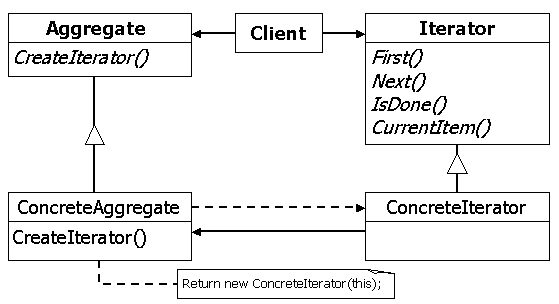Iterator
Contents
The Iterator Pattern is commonly used in Computer Science as a way to access elements of a collection, regardless of how they were implemented. An iterator may also be called a cursor.
Description
An iterator may be though of as a kind of pointer that has two basic operations, referencing one particular element in a collection, and pointing to the next element in the collection. Depending on the language the iterator is implemented in, other functionality may be added to the iterator object.
The purpose of an iterator is to give a user a way to process each element of a container while separating the user from the internal structure of the container. This allows the container to store elements however it wants to, while allowing the user to use it as if it were just a simple list or sequence. An iterator class is usually designed in coordination with the container class, which usually provides methods or functions for creating iterators.
An easy way to think of iterators, is to also think of, Lists, Linked Lists, Binary Trees, and Hash Tables, because they operate very much in the same way that iterators do.
Implicit Iterators
Some object-oriented languages have iterator support included within the language, without having to implement an explicit iterator object. Some of these language include:
- C#
- Java (After 5.0)
- Python
- PERL
UML
Here is a UML Diagram of the Iterator Pattern.
Code Samples
The following are samples of code from C#, Java, Python, and PERL, displaying how they implement iterators.
C#
// C#, implicit iteration foreach (Value v in list) Console.WriteLine(v);
Java
// Java, J2SE 5.0, implicit iteration for (Value v : list) System.out.print(v);
Python
# Python, implicit iteration for Value in List: print Value
PERL
# Perl, implicit iteration
foreach $val (@list) {
print "$val\n";
}
